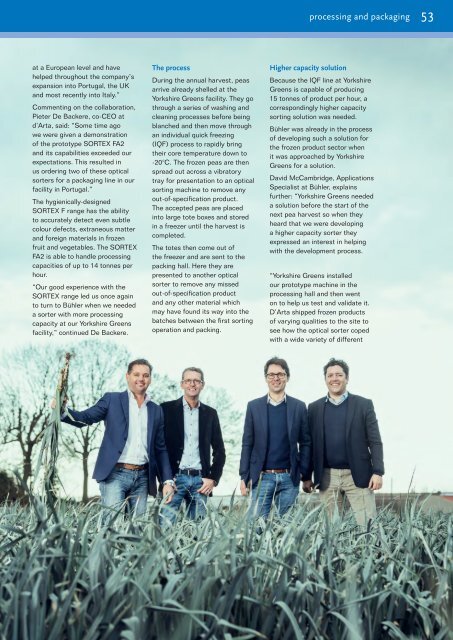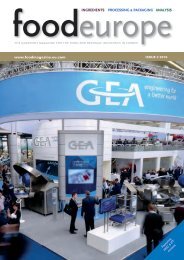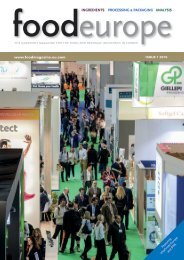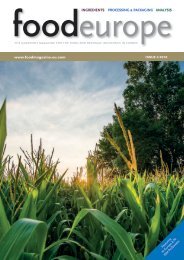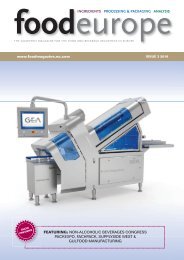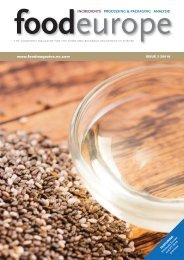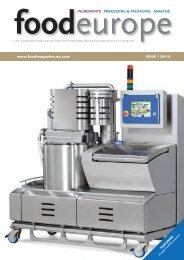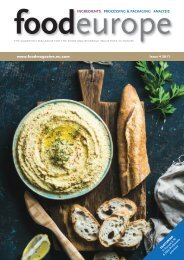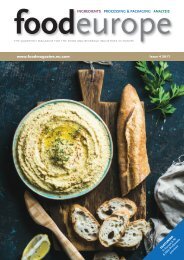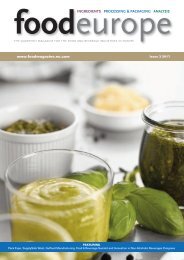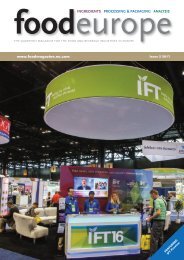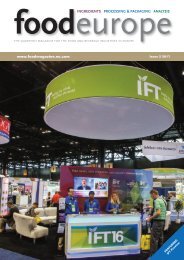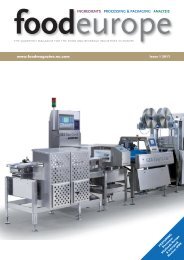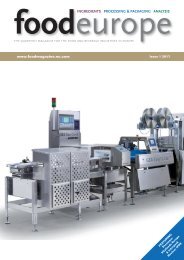Issue 3 2019
You also want an ePaper? Increase the reach of your titles
YUMPU automatically turns print PDFs into web optimized ePapers that Google loves.
processing and packaging<br />
53<br />
at a European level and have<br />
helped throughout the company’s<br />
expansion into Portugal, the UK<br />
and most recently into Italy.”<br />
Commenting on the collaboration,<br />
Pieter De Backere, co-CEO at<br />
d’Arta, said: “Some time ago<br />
we were given a demonstration<br />
of the prototype SORTEX FA2<br />
and its capabilities exceeded our<br />
expectations. This resulted in<br />
us ordering two of these optical<br />
sorters for a packaging line in our<br />
facility in Portugal.”<br />
The hygienically-designed<br />
SORTEX F range has the ability<br />
to accurately detect even subtle<br />
colour defects, extraneous matter<br />
and foreign materials in frozen<br />
fruit and vegetables. The SORTEX<br />
FA2 is able to handle processing<br />
capacities of up to 14 tonnes per<br />
hour.<br />
“Our good experience with the<br />
SORTEX range led us once again<br />
to turn to Bühler when we needed<br />
a sorter with more processing<br />
capacity at our Yorkshire Greens<br />
facility,” continued De Backere.<br />
The process<br />
During the annual harvest, peas<br />
arrive already shelled at the<br />
Yorkshire Greens facility. They go<br />
through a series of washing and<br />
cleaning processes before being<br />
blanched and then move through<br />
an individual quick freezing<br />
(IQF) process to rapidly bring<br />
their core temperature down to<br />
-20°C. The frozen peas are then<br />
spread out across a vibratory<br />
tray for presentation to an optical<br />
sorting machine to remove any<br />
out-of-specification product.<br />
The accepted peas are placed<br />
into large tote boxes and stored<br />
in a freezer until the harvest is<br />
completed.<br />
The totes then come out of<br />
the freezer and are sent to the<br />
packing hall. Here they are<br />
presented to another optical<br />
sorter to remove any missed<br />
out-of-specification product<br />
and any other material which<br />
may have found its way into the<br />
batches between the first sorting<br />
operation and packing.<br />
Higher capacity solution<br />
Because the IQF line at Yorkshire<br />
Greens is capable of producing<br />
15 tonnes of product per hour, a<br />
correspondingly higher capacity<br />
sorting solution was needed.<br />
Bühler was already in the process<br />
of developing such a solution for<br />
the frozen product sector when<br />
it was approached by Yorkshire<br />
Greens for a solution.<br />
David McCambridge, Applications<br />
Specialist at Bühler, explains<br />
further: “Yorkshire Greens needed<br />
a solution before the start of the<br />
next pea harvest so when they<br />
heard that we were developing<br />
a higher capacity sorter they<br />
expressed an interest in helping<br />
with the development process.<br />
“Yorkshire Greens installed<br />
our prototype machine in the<br />
processing hall and then went<br />
on to help us test and validate it.<br />
D’Arta shipped frozen products<br />
of varying qualities to the site to<br />
see how the optical sorter coped<br />
with a wide variety of different<br />
www.foodmagazine.eu.com issue three <strong>2019</strong>


